U.S. Congress and citizens
United States Congress and citizens describes the relation between the public and lawmakers. Essentially, American citizens elect members of Congress every two years who have the duty to represent their interests in the national legislature of the United States.
All congressional officials try to serve two distinct purposes which sometimes overlap––representing their constituents (local concerns) and making laws for the nation (national concerns).[1] There has been debate throughout American history about how to straddle these dual obligations of representing the wishes of citizens while at the same time trying to keep mindful of the needs of the entire nation.[2] Often, compromise is required.[1]
Challenges of reelection

Every two years a congressperson faces reelection, and as a result there is a strong tendency for a congressperson seeking reelection to focus their publicity efforts at their home districts.[3] Running for re-election can be a grueling process of distant travel, fund-raising, which prevents representatives from paying attention to governing, according to some critics.[4] University of Virginia professor Larry Sabato, author of A More Perfect Constitution, proposed an amendment to organize primaries to prevent a "frontloaded calendar" long before the election to prevent a "race by states to the front of the primary pack," which subverts the national interest, in his view.[4] After each ten year census, states are allocated representatives based on population, and states can choose how to draw the congressional district boundaries. A law in 1967 abolished all at-large elections (when representatives are chosen by voters in the entire state rather than an electoral district) except in less populous states entitled to only one Representative.[5]
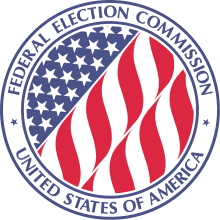
Nevertheless, congresspersons in office, or incumbents, have strong advantages over challengers.[6] One reporter noted "nearly all incumbents raise far more (money) than do their challengers," which brings a huge advantage to incumbents.[7] Incumbents get the majority of PAC money according to the logic that "PACs give most of their money to incumbents because they are more likely to win; incumbents win largely because PACs heavily finance them."[8] There is consensus among political analysts that money is important for winning elections.[9] "Election to Congress ... is therefore like getting life tenure at a university," wrote one critic.[8] In 1986, of 469 House and Senate elections, only 12 challengers succeeded in defeating incumbents.[8] Most challengers are at a huge disadvantage in terms of fundraising.[10]

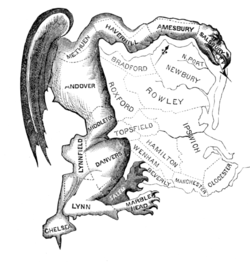
Advantages which incumbents enjoy over challengers, and which have been a source of criticism and controversy, are access to campaign contributions as well as gerrymandering[11] which give incumbents an unfair advantage, according to some critics. As a result, re-election rates of members of Congress seeking repeated terms hovers around 90% according to many sources.[12] Sometimes members of Congress are seen as a "privileged class" with cozy relations with lobbyists and free use of official resources.[13] Academics such as Princeton's Stephen Macedo have proposed solutions to fix gerrymandering.[14] Campaign costs have risen steadily over time. In 1971, the cost of running for congress in Utah was $70,000.[15] Since then, campaign costs have climbed.[16] The biggest campaign expense is television ads, although campaign staff and materials are expensive too.[15][17][17] By 1986, the average Senate race cost $3 million; average House races cost $350,000.[8] By 1994, the cost to run for a congressional seat was about $500,000 on average; in 2004, a decade later, the cost was significantly higher.[18][19] "Largely because of the ever-increasing cost of television advertising, the average price tag for waging a winning campaign is likely to zoom past the million-dollar mark this year for the first time, analysts say," according to one report.[19] Money plays a huge role in congressional elections.[17] Since fundraising is vital, "members of Congress are forced to spend ever-increasing hours raising money for their re-election" and "campaign costs continue to skyrocket."[20] Nevertheless, the Supreme Court has treated campaign contributions as a free speech issue.[16] Some see money as a good influence in politics since it "enables candidates to communicate with voters and parties to organize efforts to get out the vote."[16] In the 2008 election, spending for all campaigns (including presidential) approached $2 billion in early 2008.[21] Few members retire from Congress without complaining about how much it costs to campaign for reelection.[13] Further, after being reelected, congresspersons are more likely to attend to the needs of heavy campaign contributors than to ordinary citizens.[13] Some political scientists speculate there is a coattail effect when a popular president or party position has the effect of reelecting incumbents who get dragged along to victory as if they were "riding on the president's coattails", although there is some evidence that the coattail effect is irregular and possibly has been declining since the 1950s.[6]
To be reelected, congresspersons must advertise heavily on television; unfortunately, this almost always requires so-called negative advertising which is considered by political operatives as necessary. Critics often point to attack ads that smear an opponent's reputation or make unfounded accusations without discussing issues as being unpopular with the public. The consensus is that negative advertising is effective since "the messages tend to stick."[22] Attack ads are prevalent in most Congressional races today.[23] Critics charge that candidates must spend heavily to get elected and races often cost millions of dollars.[24] In recent years, the average victor in a Senate race spent close to $7 million, and the average House victor spent over a million dollars.[13] Some districts are so heavily Democratic or Republican that they are called a safe seat; any candidate winning the primary will almost always be elected, and don't need to spend money on advertising.[25][26] When a Congressional seat becomes vacant, then both parties may spend heavily on advertising in these so-called "competitive races"; in California in 1992, only four of twenty races for House seats were considered "highly competitive".[27]
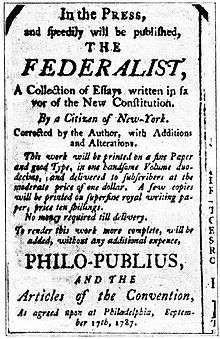
So why is there such apathy on the part of voters, particularly towards Congress? Prominent Founding Fathers writing in the Federalist Papers believed it was "essential to liberty that the government in general should have a common interest with the people," and felt that a bond between the people and the representatives was "particularly essential."[28] They wrote "frequent elections are unquestionably the only policy by which this dependence and sympathy can be effectually secured."[28] In 2009, however, few Americans were familiar with leaders of Congress.[29] Numerous reports suggest voter apathy is widespread and growing.[30][31]

The percentage of Americans eligible to vote who did, in fact, vote was 63% in 1960, but has been falling since.[32] Public opinion polls asking people if they approve of the job Congress is doing have, in the last few decades, generally been low.[13][33] Approval ratings in December 2007 were 25%, meaning only 1 out of 4 Americans approved of Congress.[34] Approval ratings from 1974 to 2009 have varied within a range from 20% to 50%, with variation, with a spike of over 84% in October 2001 after the 9/11 attacks.[33] From 2006 to 2009, ratings have hovered in the 25% range, with a high of 37% in early 2007, and an all-time low of 14% in late 2008.[35] Vanderbilt professor Dana D. Nelson in Bad for Democracy argues that all citizens seem to do, politically, is vote for president every four years, and not much else; they've abandoned politics.[36] Apathy was lower in the 2008 election, which featured a competitive election for president.[37] However, voter turnout in 2008 (62%) was the highest since 1968.[38]

Why explains public attitudes towards Congress? Scholar Julian E. Zeliger suggested that the "size, messiness, virtues, and vices that make Congress so interesting also create enormous barriers to our understanding the institution ... unlike the presidency, Congress is difficult to conceptualize."[39] And scholars Steven S. Smith, Jason M. Roberts, and Ryan J. Vander Wielen suggest that despite the criticism, "Congress is a remarkably resilient institution ... its place in the political process is not threatened ... it is rich in resources."[40] They contend that "Congress is easy to dislike and often difficult to defend." Many challengers running for Congress run against Congress which is an "old form of American politics" which further undermines Congress's reputation with the public as a whole.[13] They write:
| “ | The rough-and-tumble world of legislating is not orderly and civil, human frailties too often taint its membership, and legislative outcomes are often frustrating and ineffective ... Still, we are not exaggerating when we say that Congress is essential to American democracy. We would not have survived as a nation without a Congress that represented the diverse interests of our society, conducted a public debate on the major issues, found compromises to resolve conflicts peacefully, and limited the power of our executive, military, and judicial institutions ... The popularity of Congress ebbs and flows with the public's confidence in government generally ... the legislative process is easy to dislike––it often generates political posturing and grandstanding, it necessarily involves compromise, and it often leaves broken promises in its trail. Also, members of Congress often appear self-serving as they pursue their political careers and represent interests and reflect values that are controversial. Scandals, even when they involve a single member, add to the public's frustration with Congress and have contributed to the institution's low ratings in opinion polls.[13] | ” |
But the political scientists believe that the large majority of today's members behave ethically.[13]
An additional factor which confounds perceptions of Congress is that the "issues facing Congress are becoming more technical and complex," according to one source.[13] They require expertise in areas such as science, engineering, and economics.[13] As a result, Congress often cedes authority to experts at the executive branch, although this can enhance the executive branch's power over the details of public policy.[13] When Congress deals with complex issues, complex unwieldy bills can result.[13]

Political scientists have noted how a prolonged period marked by narrow majorities in both chambers of Congress has affected partisanship.[41] There is speculation that the alternating control of Congress between Democrats and Republicans will lead to greater flexibility in policies, more pragmatic choices, and greater civility within the institution, and possibly greater public support.[42] There is hope that this will be an improvement from the partisanship of the past few decades.[43]
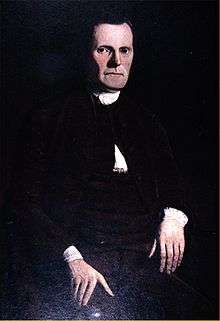
Smaller states and bigger states
When the Constitution was ratified in 1787, the ratio of the populations of large states to small states was roughly twelve–to–one. The Connecticut Compromise gave every state, large and small, an equal vote in the Senate.[44] Since each state has two senators, residents of smaller states have more clout in the Senate than residents of larger states. But since 1787, the population disparity between large and small states has grown; in 2006, for example, California had seventy times the population of Wyoming.[45] Critics have charged that the population disparity works against residents of large states. University of Texas law professor Sanford Levinson criticizes the imbalance of power in the Senate as causing a steady redistribution of resources from blue states to red states and from "large states to small states."[46][47] University of Kentucky professor Richard Labunski agrees that small states have an unfair advantage in the Senate, writing: "If the 26 least populated states voted as a bloc, they would control the U.S. Senate with a total of just under 17% of the country’s population."[48] However, others argue that the Connecticut compromise was deliberately intended by the Framers to construct the Senate so that each state had equal footing not based on population,[44] and contend that the result works well on balance.

Congresspersons and constituents
A major aspect of the role for a Senator and a representative consists of services to his or her constituency. Members receive thousands of letters, phone calls, and e-mails, with some expressing opinion on an issue, or displeasure with a member's position or vote. Often the incoming messages are not from concerned citizens but are barrages of electronic mail and interactive video designed to pressure the congressperson and his or her staff.[13] Constituents request assistance with particular problems or ask questions. Members of Congress want to leave a positive impression on the constituent, rather than leave them disgruntled. Thus, their offices will often be responsive, and go out of their way to help steer the citizen through the intricacies of the bureaucracy. In this role, members and their staffers act as an ombudsman at the Federal level. This unofficial job has become increasingly time-consuming, and has significantly reduced the time that members have for the preparation or inspection of bills.[49] Providing services helps congresspersons win elections and there are reports that some congresspersons compete actively to try to convince voters that they deliver the best services.[11][50][51] It can make a difference in close races. For example, Erika Hodell-Cotti talked about how her congressperson, Frank Wolf, sent her letters when her children got awards; the congressperson helped her brothers win admission to the West Point Military Academy.[52] Much of what citizens want is merely help with navigating government bureaucracies.[53]
An incumbent member of Congress has considerably more clout than most official ombudsmen at the state level, and in other countries, given the appointive and relatively diminutive character of such offices. As Morris Fiorina notes, the involvement of the legislative branch in the ombudsman process carries one major advantage: members of Congress exercise "control over what bureaucrats value most – higher budgets and new program authorizations."[54] This kind of leverage over the bureaucracy is a potent tool that appointed ombudsmen lack. Accordingly, to improve on today's 435 de facto ombudsmen—constituent services by overworked Congressmen—congressional reforms have been proposed that would approximate the legislative leverage now exercised by Congressmen, but in an office where the intra-bureaucratic troubleshooting duties are full-time.[55] Along these lines, some Congressmen themselves have suggested that each congressional district should elect a second U.S. Representative to handle constituent services.[56]
One academic described the complex, intertwined relation between lawmakers and constituents as home style.[57] Political scientist Lawrence Dodd suggested voters often choose a "powerful local incumbent who can assist with a desired local defense contract" rather than a reform-minded challenger who, if elected, wouldn't have much clout or power since he or she would lack seniority.[13]
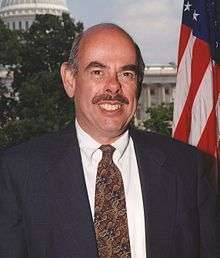
One way to categorize lawmakers is by their general motivation, according to political scientist Richard Fenno: (1) reelection—these are lawmakers who "never met a voter they didn't like" and provide excellent constituent services (2) good public policy –– legislators who "burnish a reputation for policy expertise and leadership" and (3) power in the chamber –– those who spend serious time along the "rail of the House floor or in the Senate cloakroom ministering to the needs of their colleagues."[57] Famous legislator Henry Clay in the mid-19th century was described as an "issue entrepreneur" who looked for issues to serve his ambitions.[57]
What's come to describe most congresspersons today is a need to avoid blame.[58] One wrong decision or one damaging television image can mean defeat at the next election. Accordingly, some academics suggest there is a culture of risk avoidance as well as a need to make policy decisions behind closed-doors[58] along with efforts to focus their publicity efforts at their home districts.[3]
References
- 1 2 Steven S. Smith; Jason M. Roberts; Ryan J. Vander Wielen (2006). "The American Congress (Fourth Edition)". Cambridge University Press. Retrieved 2010-09-11.
... Congress serves two, not wholly compatible, purposes – representation and lawmaking. Members of the House and Senate serve individual districts or states, yet they must act collectively to make law for the nation as a whole. Collective action on divisive issues entails bargaining and compromise – among the members of each house, between the House and the Senate, and between Congress and the president. For compromise to be possible, members sometimes retreat from their commitments to their individual state or district. Determining who must compromise – and how to get them to do so – is the essence of legislative politics. (see pages 25-26)
- ↑ Julian E. Zelizer (editor) Joanne Barrie Freeman, Jack N. Rakove, Alan Taylor; et al. (2004). "The American Congress: The Building of Democracy". Houghton Mifflin Company. ISBN 0-618-17906-2. Retrieved 2010-09-11.
Texan Sam Rayburn in 1940s & 1950s met in a former committee room called the "Board of Education" in the Capitol's ground floor ... "in many ways it was like the closed rooms of other congressional eras: a place where senators and representatives could meet and do the hard business of a legislature: discuss, deal, compromise, and finally agree to act on the nation's problems." page xiii, xiv
- 1 2 Julian E. Zelizer (editor) Michael Schudson (author) (2004). "The American Congress: The Building of Democracy". Houghton Mifflin Company. ISBN 0-618-17906-2. Retrieved 2010-09-11.
The media became increasingly important in the work of Congress in the late twentieth century ... more actors participated, more actions took place in a public arena, more roads opened up in Congress for individual representatives to influence decisions ...
- 1 2 Larry J. Sabato (September 26, 2007). "An amendment is needed to fix the primary mess". USA Today. Retrieved 2009-09-20.
- ↑ John V. Sullivan (July 24, 2007). "How Our Laws Are Made". The Library of Congress. Retrieved 2010-09-11.
A law enacted in 1967 abolished all at-large elections except in those less populous states entitled to only one Representative. An at-large election is one in which a Representative is elected by the voters of the entire state rather than by the voters in a congressional district within the state.
- 1 2 Steven S. Smith; Jason M. Roberts; Ryan J. Vander Wielen (2006). "The American Congress (Fourth Edition)". Cambridge University Press. Retrieved 2010-09-11.
... The Federal Election Campaign Act (FECA) of 1971, and important amendments to it in 1974 and 1976 created the Federal Election Commission (FEC) and established limits and disclosure requirements for contributions to congressional campaigns. ... FECA restricted the size of contributions that individuals, parties, and political action committees (PACs) could make to candidates for Congress. ... Because PACs may contribute more than individuals, there is a strong incentive to create PACs, which grew in number from 608 in late 1974 to more than 4,000 in the mid-1980s and have remained just over 4,000 in number since then.. (see page 58)
- ↑ Richard E. Cohen (August 12, 1990). "PAC Paranoia: Congress Faces Campaign Spending - Politics: Hysteria was the operative word when legislators realized they could not return home without tougher campaign finance laws.". Los Angeles Times. Retrieved 2009-10-02.
- 1 2 3 4 Joseph A. Califano Jr. (May 27, 1988). "PAC's Remain a Pox". The New York Times. Retrieved 2009-10-02.
- ↑ Brian Kalish (2008-05-19). "GOP exits to cost party millions". USA TODAY. Retrieved 2009-10-01.
- ↑ ADAM CLYMER, (October 29, 1992). "CAMPAIGN SPENDING IN CONGRESS RACES SOARS TO NEW HIGH". New York Times. Retrieved 2009-10-02.
- 1 2 Susan Page (May 9, 2006). "5 keys to who will control Congress: How immigration, gas, Medicare, Iraq and scandal could affect midterm races". USA TODAY. Retrieved 2010-09-11.
Republicans have counted on financial advantage, redrawn district lines and the power of parochial issues and constituent services to hold narrow majorities in Congress since they won control 12 years ago.
- ↑ Perry Bacon Jr. (August 31, 2009). "Post Politics Hour: Weekend Review and a Look Ahead". Washington Post. Retrieved 2009-09-20.
- Huckabee, David C. (2003). Reelection Rates of Incumbents. Hauppauge, New York: Novinka Books, an imprint of Nova Science Publishers. p. 21. ISBN 1590335090.
- David C. Huckabee -- Analyst in American National Government -- Government Division (1995-03-08). "Reelection rate of House Incumbents 1790-1990 Summary (page 2)" (.PDF). Congressional Research Service -- The Library of Congress. Retrieved 2009-09-20.
- Janice Francis-Smith (2008-10-22). "Waging campaigns against incumbents in Oklahoma". The Oklahoma City Journal Record. Retrieved 2009-09-20.
- "How To Clean Up The Mess From Inside The System, A Plea--And A Plan--To Reform Campaign Finance Before It's Too". NEWSWEEK. October 28, 1996. Retrieved 2009-09-20.
- 1 2 3 4 5 6 7 8 9 10 11 12 13 14 Steven S. Smith; Jason M. Roberts; Ryan J. Vander Wielen (2006). "The American Congress (Fourth Edition)". Cambridge University Press. Retrieved 2010-09-11.
Congress is created by its members and frequently changed by its members. Consequently, we emphasize the factors that influence legislators' thinking about their institution. Party conflict, competition with the executive branch, the drive for reelection, and other forces in congressional politics are discussed.
- ↑ Macedo, Stephen (August 11, 2008). "Toward a more democratic Congress? Our imperfect democratic constitution: the critics examined" (PDF). Boston University Law Review. Boston University Law Review. 89: 609–628. Retrieved 2009-09-20.
- 1 2 "Time Essay: Campaign Costs: Floor, Not Ceiling". Time Magazine. May 17, 1971. Retrieved 2009-10-01.
- 1 2 3 Barbara Borst, Associated Press (2006-10-29). "Campaign spending up in U.S. congressional elections". USA Today. Retrieved 2009-10-01.
- 1 2 3 Dan Froomkin (September 15, 1997). "Campaign Finance -- Introduction". Washington Post. Retrieved 2009-10-01.
- ↑ Evan Thomas (April 4, 2008). "At What Cost? -- Sen. John Warner and Congress's money culture.". Newsweek. Retrieved 2009-10-01.
- 1 2 Jeffrey H. Birnbaum (October 3, 2004). "Cost of Congressional Campaigns Skyrockets". Washington Post. Retrieved 2009-10-01.
- ↑ PR Newswire (May 19, 2009). "Campaign Finance Groups Praise Rep. Welch for Cosponsoring Fair Elections Now Act". Reuters. Retrieved 2009-10-01.
- ↑ James Oliphant (April 9, 2008). "'08 Campaign costs nearing $2 Billion. Is it worth it?". Los Angeles Times. Retrieved 2009-10-01.
- ↑ Howard Kurtz (January 6, 2008). "CAMPAIGN ON TELEVISION People May Dislike Attack Ads, but the Messages Tend to Stick". Washington Post. Retrieved 2009-09-30.
- ↑ "References about prevalence of attack ads".
- LESLEY CLARK (2008-10-18). "Attack ads knock out issues in Lincoln Diaz-Balart/Raul Martinez race -- The issues get short shrift in the blizzard of ads and mailers in the nationally watched race between U.S. Rep. Lincoln Diaz-Balart and Raul Martinez.". The Miami Herald. Retrieved 2009-09-30.
- Brooks Jackson & Justin Bank (February 5, 2009). "Radio, Radio -- New Democratic ads attacking House Republicans in the lead-up to the 2010 midterm elections don't tell the whole story.". Newsweek. Retrieved 2009-09-30.
- Fredreka Schouten (2008-09-19). "Union helps non-profit groups pay for attack ads". USA Today. Retrieved 2009-09-30.
- Ruth Marcus (August 8, 2007). "Attack Ads You'll Be Seeing". Washington Post. Retrieved 2009-09-30.
- Chris Cillizza (September 20, 2006). "Ads, Ads Everywhere!". Washington Post. Retrieved 2009-09-30.
- SAMANTHA GROSS Associated Press (September 7, 2007). "Coming Soon: Personalized Campaign Ads". Washington Post. Retrieved 2009-09-30.
- ↑ "References about diffname".
- JEAN MERL (October 18, 2000). "Gloves Come Off in Attack Ads by Harman, Kuykendall". Los Angeles Times. Retrieved 2009-09-30.
- Shanto Iyengar -- Director, Political Communications Lab, Stanford University (August 12, 2008). "Election 2008: The Advertising". Washington Post. Retrieved 2009-09-30.
- DAVE LESHER (September 12, 1994). "COLUMN ONE - TV Blitz Fueled by a Fortune - Once obscure, Huffington now is pressing Feinstein. His well-financed rapid-response team has mounted an unprecedented ad attack.". Los Angeles Times. Retrieved 2009-09-30.
- Howard Kurtz (October 28, 1998). "Democrats Chase Votes With a Safety Net". Washington Post. Retrieved 2009-09-30.
- ↑ John Balzar (May 24, 2006). "Democrats Battle Over a Safe Seat in Congress". Los Angeles Times. Retrieved 2009-09-30.
- ↑ "The Congress: An Idea on the March". Time Magazine. Jan 11, 1963. Retrieved 2009-09-30.
- ↑ staff writer (October 25, 1992). "Decision '92 - SPECIAL VOTERS' GUIDE TO STATE AND LOCAL ELECTIONS - THE CONGRESSIONAL RACES". Los Angeles Times. Retrieved 2009-09-30.
- 1 2 Alexander Hamilton or James Madison (February 8, 1788). "US Constitutional Documents: The Federalist Paper No. 52". Retrieved 2009-10-01.
- ↑ "Congress` Approval Rating at Lowest Point for Year". Reuters. September 2, 2009. Retrieved 2009-10-01.
- ↑ "THE CONGRESS: Makings of the 72nd (Cont.)". Time Magazine. September 22, 1930. Retrieved 2009-10-01.
- ↑ JONATHAN PETERSON (October 21, 1996). "Confident Clinton Lends Hand to Congress Candidates". Los Angeles Times. Retrieved 2009-10-01.
- ↑ "References about diffname".
- "THE CONGRESS: Makings of the 72nd (Cont.)". Time Magazine. September 22, 1930. Retrieved 2009-10-01.
- MAKI BECKER (June 17, 1994). "Informed Opinions on Today's Topics - Looking for Answers to Voter Apathy". Los Angeles Times. Retrieved 2009-10-01.
- Daniel Brumberg (October 30, 2008). "America's Re-emerging Democracy". Washington Post. Retrieved 2009-10-01.
- KAREN TUMULTY (July 8, 1986). "Congress Must Now Make Own Painful Choices". Los Angeles Times. Retrieved 2009-10-01.
- JANET HOOK (December 22, 1997). "As U.S. Economy Flows, Voter Vitriol Ebbs". Los Angeles Times. Retrieved 2009-10-01.
- 1 2 Gallup Poll/Newsweek (2009-10-08). "Congress and the Public: Congressional Job Approval Ratings Trend (1974-Present)". The Gallup Organization. Retrieved 2009-10-08.
- ↑ Associated Press (1/9/2008). "Congress gets $4,100 pay raise". USA Today. Retrieved 2009-09-28. Check date values in:
|date=(help) - ↑ "References about low approval ratings".
- "Congress' Approval Rating Jumps to 31%". Gallup. February 17, 2009. Retrieved 2009-10-01.
- "Congress` Approval Rating at Lowest Point for Year". Reuters. September 2, 2009. Retrieved 2009-10-01.
- John Whitesides (2007-09-19). "Bush, Congress at record low ratings: Reuters poll". Reuters. Retrieved 2009-10-01.
- Seung Min Kim (2009-2-18). "Poll: Congress' job approval at 31%". USA TODAY. Retrieved 2009-10-01. Check date values in:
|date=(help)
- ↑ interview by David Schimke (September–October 2008). "Presidential Power to the People -- Author Dana D. Nelson on why democracy demands that the next president be taken down a notch". Utne Reader. Retrieved 2009-09-20.
- ↑ Guy Gugliotta (November 3, 2004). "Politics In, Voter Apathy Out Amid Heavy Turnout". Washington Post. Retrieved 2009-10-01.
- ↑ Associated Press (December 15, 2008). "Voter Turnout Rate Said to Be Highest Since 1968". Washington Post. Retrieved 2009-10-01.
- ↑ Julian E. Zelizer (editor) (2004). "The American Congress: The Building of Democracy". Houghton Mifflin Company. ISBN 0-618-17906-2. Retrieved 2010-09-11.
The very messiness of congressional decisions, which is often lamented by commentators, reflects the diversity and richness of the nation ... The size, messiness, virtues, and vices that make Congress so interesting also create enormous barriers to our understanding the institution. Unlike the presidency, Congress is difficult to conceptualize... page xiv, xv
- ↑ Steven S. Smith; Jason M. Roberts; Ryan J. Vander Wielen (2006). "The American Congress (Fourth Edition)". Cambridge University Press. Retrieved 2010-09-11.
... we should remember that Congress is a remarkably resilient institution. Its place in the political process is not threatened. It is rich in resources; critics even charge that it is too strong. ... the legitimacy of its decisions is not seriously questioned by the chief executive, the courts, the states or the American people. (see page 23)
- ↑ Steven S. Smith; Jason M. Roberts; Ryan J. Vander Wielen (2006). "The American Congress (Fourth Edition)". Cambridge University Press. Retrieved 2010-09-11.
With an evenly divided electorate, we have experienced a prolonged period of narrow majorities in both chambers of Congress in the last decade (see page 17)
- ↑ Steven S. Smith; Jason M. Roberts; Ryan J. Vander Wielen (2006). "The American Congress (Fourth Edition)". Cambridge University Press. Retrieved 2010-09-11.
... alternating control of Congress produces greater flexibility in party policy positions, more pragmatic party strategies, greater civility in political discourse, and perhaps greater public support for the institution. Early evidence may have supported his argument. (see page 18)
- ↑ Steven S. Smith; Jason M. Roberts; Ryan J. Vander Wielen (2006). "The American Congress (Fourth Edition)". Cambridge University Press. Retrieved 2010-09-11.
... By many accounts, the Congress has been more partisan since the turn of the new century than it had been for a hundred years. Poor personal relations among leaders of the two parties, the exclusion of minority party legislators from some conference committee meetings, minority obstructionism on judicial nominations, personal campaigning against incumbents of the opposite party, and other developments are cited by insiders as evidence of deteriorating relations across party lines. (see page 18)
- 1 2 "Roger Sherman and The Connecticut Compromise". Connecticut Judicial Branch: Law Libraries. 2010-01-10. Retrieved 2010-01-10.
When the Constitutional Convention became deadlocked over the matter of legislative voting, Sherman proposed a system similar to one he had advocated previously as a delegate to the Continental Congress in 1776. The compromise provided for representation in the House of Representatives according to population and in the Senate by equal numbers for each state.
- ↑ Cass R. Sunstein (October 26, 2006). "It Could Be Worse". The New Republic Online. Retrieved 2010-01-10.
Under the Constitution, every state, regardless of population, receives two senators for a period of six years. This is a conspicuous violation of the rule of "one person, one vote." Wyoming, with about 500,000 people, has the same number of senators as California, with about 35 million people.
- ↑ Reviewed by Robert Justin Lipkin (January 2007). "OUR UNDEMOCRATIC CONSTITUTION: WHERE THE CONSTITUTION GOES WRONG (AND HOW WE THE PEOPLE CAN CORRECT IT)". Widener University School of Law. Retrieved 2009-09-20.
- ↑ Sanford Levinson (2006). "Our Undemocratic Constitution". Google Books. Retrieved 2010-01-10.
Over the period of 1963–1999, New York taxpayers paid out $252 billion more in taxes than were received back in federal payments or services. Other major outpayers were California, Illinois, and New Jersey,... (page 60)
- ↑ Richard Labunski interviewed by Policy Today's Dan Schwartz (18 October 2007). "Time for a Second Constitutional Convention?". Policy Today. Retrieved 2009-09-20.
- ↑ Congressional Quarterly Weekly Report 35 (September 3, 1977): 1855. English, op. cit., pp. 48-49, notes that members will also regularly appear at local events in their home district, and will maintain offices in the home congressional district or state. Davidson (2006) reports that, on average, each Senator spends 80 days each year in their home state, while Congressmen spend 120 days in their home district.
- ↑ Robert Preer (August 15, 2010). "Two Democrats in Senate race stress constituent services". Boston Globe. Retrieved 2010-09-11.
In the Democratic race for state Senate in the Norfolk and Plymouth district, two veteran Quincy politicians are touting their ability to connect with constituents and deliver services. “I have a record of serving people in the district, and my votes reflect the interests and desires of the district.’’
- ↑ Daniel Malloy (August 22, 2010). "Incumbents battle association with stimulus, Obama". Pittsburgh Post-Gazette. Retrieved 2010-09-11.
Democrats have not articulated a national agenda along the lines of their "New Direction for America" in 2006 when they took over the House, instead emphasizing regional concerns. Mr. Altmire said constituent services are a linchpin of what he provides, and he spoke with pride about a $200,000 federal grant announced last week for the Farrell School District libraries in Mercer County. "That's what people remember," he said. "You build up a reputation for responding to their concerns."
- ↑ Amy Gardner (November 27, 2008). "Wolf's Decisive Win Surprised Even the GOP". Washington Post. Retrieved 2010-09-11.
And he runs an efficient constituent services operation with a personal touch, writing letters and making phone calls when residents of the district need help. "His assistance to my family has spanned decades for us," said Erika Hodell-Cotti, 35, of Loudoun County, whose two brothers attended West Point Academy on the recommendation of Wolf, and who more recently received his help while navigating the world of international adoptions with her 17-month-old son from Korea. "If you talk to people about Frank Wolf, a lot of people say, 'Boy he's been around a little too long,' " Brodnitz said. " 'But he always sends me mail. We got a letter when my kid graduated from, whatever it was, he got an award.' He has very good constituent services and people have these little experiences with him."
- ↑ Lee Hamilton (2004). "How Congress works and why you should care". Indiana University Press. ISBN 0-253-34425-5. Retrieved 2010-09-11.
James Madison, principal drafter of the Constitution, held that in a representative democracy like ours, "the legislative authority necessarily dominates."
- ↑ Morris P. Fiorina, "The Case of the Vanishing Marginals: The Bureaucracy Did It," American Political Science Review 71 (March 1977): 179-80.
- ↑ Struble, supra, chapter seven, subsection on "Ombudsman Functions"
- ↑ Charles L. Clapp, The Congressman, His Work as He Sees It (Washington, D.C.: The Brookings Institution, 1963), p. 55; cf. pp. 50-55, 64-66, 75-84.
- 1 2 3 William T. Blanco, Editor (2000). "Congress on display, Congress at work". University of Michigan. ISBN 0-472-08711-8. Retrieved 2010-09-11.
Over the past 20 years, the term home style has become shorthand in the literature on congressional elections to describe the complex, intertwined relationship between legislators and their constituents.
- 1 2 Steven S. Smith; Jason M. Roberts; Ryan J. Vander Wielen (2006). "The American Congress (Fourth Edition)". Cambridge University Press. Retrieved 2010-09-11.
... many members turned from wanting to claim credit for legislative accomplishments to avoiding blame for making unpopular choices. ... it changed lawmakers' basic approach to policy making. Major decisions were made in closed-door sessions between top party and budget leaders and top administration officials rather than in open meetings in dozens of committees and subcommittees. The desire to avoid blame was also evident in the policy choices Congress made. Instead of considering the merits of individual programs, lawmakers passed broad spending caps or across-the-board spending freezes. (see page 21)